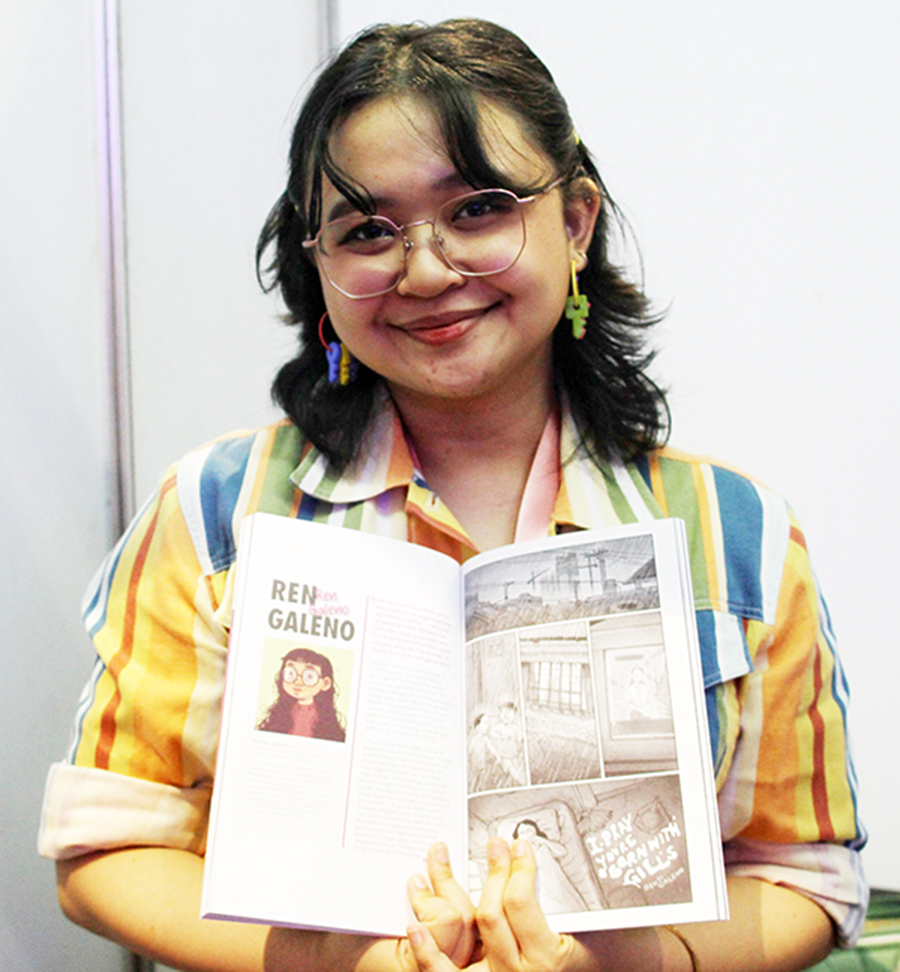DAVAO CITY – Every comic artist dreams to get their work published on the pages of notable publications.
But for a 27-year-old Davaoeña comics artist, getting an email from one of the most respected newspapers in the world was the least she expected.

REN Galeno shows her work for an anthology book ‘Ten Years to Save the World’ during the Philippine Book Festival at SMX Convention Center in Davao City. (Keith Bacongco)
“I didn't think it was real at first,” recalled Ren Galeno, adding that she was working when she received an email from Washington Post last February 24.
"I actually thought it was just a spam email," she told Manila Bulletin with a chuckle. Of course, I'm wishing for a big break but I did not expect this to happen this soon."
Galeno was behind the evocative illustrations for the Washington Post’s “Searching for Maura,” an investigative series in an illustrated reporting form about the missing Filipino girl from Cordillera.
The story is about Maura, an 18-year-old Filipina who was taken to Saint Louis, Missouri for the World’s Fair in 1904.
"Maura fell ill and died, and records suggest a renowned Smithsonian anthropologist, Ales Hrdlicka, traveled to Saint Louis and took the cerebellum of her brain to study as part of his ‘racial brain collection,’” a part of the caption read.
Galeno recalled that an editor of the Washington Post told her that they had read “I pray you're born with gills,” a short comic she made for Ten Years to Save the World book.
She added that she had online meeting with the editors and then with the other members of the team involved in the investigative story.
“I had sent a few drawings to see if my style was what they had envisioned, a few likeness studies and a location study. They responded positively to them, and we got to work as soon as the script was finalized.”
As part of the creative process, the team sent her pictures for references.
Then she started working on the illustrations in April and eventually finished everything in June.
“They were incredible collaborators, I learned so much from this project. They were clear with their vision from the beginning,” she admitted. “It was a great collaboration, and their passion for the investigation was infectious. It was my first time working with a writer and a team, and I'm really lucky I got to learn from them.”
The Searching for Maura was perhaps the first ever story of the Washington Post translated into Filipino.
Furthermore, Galeno admitted that, as a Filipino, there was a little bit of pressure when she was working on the drawings. "I felt the pressure and the responsibility to illustrate it accurately and with empathy."
Love for drawing
According to her father Ferdinand, her daughter started to scribble around two-years-old.
“I taught her how to draw by singing the nursery rhyme Small Circle Big Circle until it is formed into a teddy bear,” recalled Ferdinand, who runs a restaurant in this city.
Since then, he had already seen her daughter’s love for drawing.
Upon finishing high school, Ferdinand recounted that her daughter wanted to take up Fine Arts in college. “Since she was not yet 18-years-old, I encouraged her to take up architecture first because I believe that it’s a good foundation for drawing. And she agreed.”
After spending a year at Ateneo de Davao University, she moved to University of the Philippines-Mindanao here and took up Communication Arts for a year before moving to UP Diliman in Quezon City to take up Fine Arts.
"I've always loved to draw. I don't remember a time when I wasn't drawing. I knew I wanted to be some kind of artist, and for a while I thought that was a painter. After graduation I just returned to comics, the transition felt natural. I had always loved manga and comics, it felt like it made sense,” Galeno said.
Body of work
Prior to her collaboration with the Washington Post, Galeno’s biggest project was for the comic anthology “Ten Years to Save the World, ” a project supported by the British Council as part of a number of creative commissions in response to climate change and COP26.
She contributed the “I pray you're born with gills,” a sobering reflection on the anxiety of bringing children into a climate change world.
Currently, she is working on her first full graphic novel "Full of Grace," an official selection of the 2nd Philippine International Comics Festival (PICOF) in September.
Moreover, she has also produced seven mini-comic books: II (2019), Sta. Monica Falls (2020), Egg (2020), Romaragit (2020), Aiyeee (2020), Sa Wala (2021), Mga Palaka ng San Antonio (2022).
Another upcoming graphic novel, "Sa Wala," is set to be released this year.
She left an advise to aspiring artists.
“Be curious and open to everything! Observe the world around you, know your interests, and allow yourself to try new things,” said Galeno.











.jpg)






